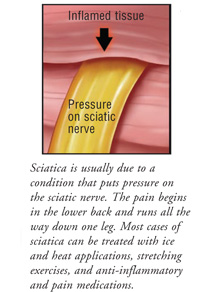 Pain Radiating Along the Sciatic Nerve
Pain Radiating Along the Sciatic Nerve
Sciatica is a common form of back and leg pain that results from compression of the sciatic nerve, a large nerve that runs from the lower spine behind the hip joint and down the back of each leg. It is usually easy to diagnose sciatica because the characteristic pain is a sharp, burning, or stabbing sensation that begins in the lower back and runs all the way down one leg, even into the foot. In severe cases of sciatica, there may be weakness or difficulty standing or moving the affected leg. Although it is a painful condition, sciatica rarely causes any permanent damage to the sciatic nerve.
The most common cause of sciatic nerve pressure and resulting pain is a slipped disc in the spine, also referred to as a herniated or ruptured disc. A disc is a cushion of cartilage between each of the bones in the spine, which acts to absorb the shock of movement and maintain spinal flexibility. If part of the jelly-like disc leaks from its capsule, it puts pressure on the sciatic nerve and leads to inflammation and pain.
Most cases of sciatica can be effectively treated by conservative therapy, such as ice and heat packs, stretching exercises, and anti-inflammatory and pain medications. Once the pain of sciatica is controlled, physical therapy can be helpful in both treatment and prevention of future episodes. Corticosteroid injections directly into the inflamed area can be helpful in some cases, and surgery is indicated if all other treatments fail after an extended duration of conservative treatment.
Self-Care Therapies Help Relieve Pain
Sciatica is pain caused by various conditions that lead to pressure on the sciatic nerve. Most cases of sciatica are caused by a herniated or bulging disc in the spine pressing on the sciatic nerve. However, sciatica can also result from degenerative disc disease (the cushioning discs in the spine become brittle and break down), spondylolisthesis (one vertebra slips over another), bone spurs (growths that jut out of the bony joints of the spine), or lumbar spinal stenosis (the spinal canal becomes narrowed). Risk factors for sciatica include older age; a family history of back problems; pregnancy or being overweight; sitting or standing for long periods of time; jobs that require long periods of sitting, bending, or lifting; and sleeping on a soft mattress.
Sciatica is usually not difficult to diagnosis after taking a thorough medical history, since the pain is characteristically on one side and runs along the lower back to the thigh, legs, and even to the ankle and foot.
Treating Pressure and Inflammation
Relief from the pain can begin with the use of ice packs for 15 minutes at a time, four or more times a day, applied to the lower back. After 48 hours of cold pack treatments, a heating pad or heat pack can be alternated with the cold packs. During the first few days of an attack, the patient should avoid the sitting position and alternate between lying down and walking as tolerated. For a severe attack of sciatica, it can take a day or two of rest on a firm bed, with periodic breaks to walk to the bathroom or stand to eat, before more activity can be attempted. Many people who experience sciatica use over-the-counter pain products such as nonsteroidal anti-inflammatory medications (if tolerated) or acetaminophen to help relieve pain; more severe pain can be relieved by prescription pain medications. Sometimes, the addition of a muscle relaxant to a pain medication is effective. The goal of treatment is to relieve pain so movement can slowly begin again.
If these measures do not relieve sciatic pain within six weeks, it may be necessary for your doctor to conduct further tests (spinal x-ray, MRI, CT scan, or nerve conduction studies) to determine if there is an underlying cause that should be treated, such as a herniated disc, tumor, or abscess. Your doctor may use a steroid injection in the inflamed area to help relieve the pressure and resulting pain. In some cases, surgery is necessary to correct the problem.
Avoiding Future Episodes
Once the pain is adequately relieved, physical therapy is an excellent way to continue healing and strengthening abdominal muscles to avoid future attacks of sciatica. Other simple measures that can help avoid sciatic pain include proper lifting and twisting techniques, avoidance of the sitting position for long periods, and regular exercise to keep fit. Many people who suffer from sciatica find that a firm mattress affords a restful night of sleep and relieves daytime back pain.





